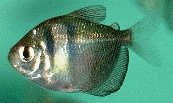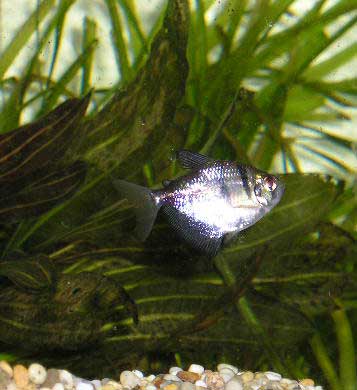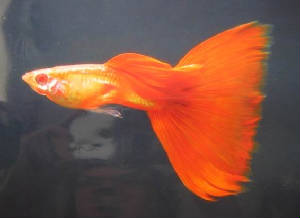|
Welcome to Miss Shylah's Class |
|
|
|
|||||||||||||||||||||||||||||||||||||||||
|
Black Skirt Tetra The Tetra is one of the most popular aquarium fish and was first introduced into the The Black Tetra, Black Widow, or Blackskirt Tetra is very active and fast moving, but can tend
towards fin nipping. Because of this they should not be kept with smaller fishes but do well in a community tank with larger
fishes. These are schooling fish and like a well lighted tank with dense areas of bunched low vegetation.
This leaves lots of open areas to swim in. They are hardy at 70° F to 90° F, but are prone to develop ick if kept in colder
temperatures. The Black Tetra, Black Widow, or Blackskirt Tetra is distinguished by two vertical stripes and
by what appears to be overly developed dorsal and anal fins making it appear as if though it has a "skirt", with most of its
mass on the bottom half of the body. The fine black color changes to a gray in the adult and with age they become a more sedentary
fish. This fish is not to be confused with its' cousin, also called the Black Tetra, is lighter with not as bold a coloration,
a more convex anal fin rather than rounding out, and they lack the vertical striping. This fish is shyer and not as hardy
as the Black Tetra, Black Widow, or Blackskirt Tetra. Various strains of the Black Tetra, Black Widow, or Blackskirt Tetra have been developed! There
is a long-finned variety first developed in There are also natural white, pink and blue strains that have been developed. The White Tetra or Goldenskirt Tetra has become very common. It is sometimes artificially dyed in various pastels colors and sold as a Colored Tetra or Colored
Skirt Tetra, or under various colored names such as the Blueberry Tetra, Strawberry Tetra, or Rainbow Tetra.
|
Blonde Delta Guppies Natural habitat The wild,
original guppy is native to Central America, as well as Trinidad and northern The Fancy
Guppy Fancy
guppies are the result of specialized breeding techniques and they only slightly resemble the small, wild guppy, often seen
in pet stores labeled "feeder fish". Credit is due these active little fish, however, which are a joy for many
who keep them. Temperature An ideal
temperature for adult guppies is 72 to 76 F. Fry are often raised in warmer water for the first 2 or 3 months (78 -
80 F). However, guppies can survive temperatures as low as 60°F and as high as 90°F. The higher the temperature in
which a guppy lives, the shorter it's life span will be. For the first part of their lives, guppies will grow faster in higher
temperatures (if sufficient food is given) so it is helpful to keep fry warm. The guppy
does well in medium-hard water. They prefer an alkaline pH (pH is the measurement of acidity/alkalinity in a specific body
of water) which can be quite high (8.0 or higher) as long as the guppy is acclimatized carefully and does not experience pH
swings. If you decided to mix guppies with other species of fish in a community tank, be very careful choosing tank
mates. Fancy guppies are more fragile than most and will not survive with aggressive or fin-nipping fish. See
the bottom of the FAQ page for more help. Interestingly,
while guppies live well without salt, they are also considered by many to be brackish (meaning they can live in a combination
of fresh and sea water), and, as a matter of fact, it is possible for guppies to live in salt water with proper conditioning. Notes An ideal
temperature for adult guppies is 72 to 76 F. Fry are often raised in warmer water for the first 2 or 3 months (78 -
80 F). The guppy
is a live bearer, with an average gestation period of 28 days. The female
guppy has drops of between 2-200 fry, normally about 30 to 60. The female
matures at about 3 months, the males earlier, at around 6 weeks. This depends on genetics and environment. The life
span for a well cared-for guppy is 1.5 to 3 years on average.
|
||||||||||||||||||||||||||||||||||||||||
|
|
|||||||||||||||||||||||||||||||||||||||||




